Sixty Years of Mission and Grace
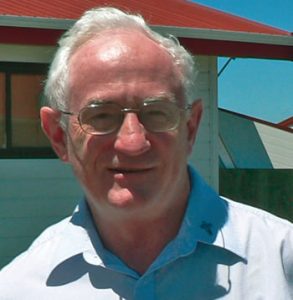
by Fr Neil Vaney SM
A Brief History of the Catholic Enquiry Centre
Part 2 of 2
Advertising
CEC launched its first advertisements in late February 1961.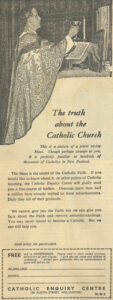
On the day after the first ad appeared there were 42 replies, nearly all from Wellington, the next day 89, followed by 95, from Auckland and Christchurch as well. By the next Wednesday 52 enrolment cards had been returned. In 1963 the advertising campaign was launched in full. The newspapers involved were the New Zealand Herald, Dominion, Christchurch Press, Christchurch Star and Evening Star. The weekly magazines were Woman’s Weekly, Weekly News, The Listener and the NZ Truth. The ad that gained the most replies carried the bald heading, The TRUTH about the CATHOLIC CHURCH.
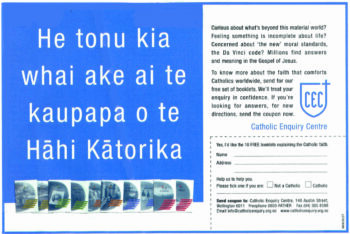
Mana News advertisement, 2007
By 1968 it was clear that weekly magazines were more effective than dailies in gaining responses. Moving to full page ads, but placed less often, also brought increased responses. In 1971, advertising had moved entirely to the Sunday Times, Sunday News, Woman’s Weekly, Listener and the NZ Truth. Summer 1974 saw the first venture into radio advertising, making the offer of a prayer book on 2ZB. This led to a decision to run the same ad on 1ZB, Radio I and Radio Windy. By 1989 it was clear that The Listener and Woman’s Weekly were the best venues, but at an appreciable cost, a half page in the former costing $1,700 and $2,800 for the latter.
September 1999 marked the first use of TV when Fr Paul Shannahan and Jocelyn Butcher (a member of the Advisory Board), appeared on the Mary Lambie show. By 2004 the strategy of placing six four minute ads on the Good Morning Show at $2,600 each had evolved. On average, each appearance would result in about a hundred calls. Four years later, shorter fifteen second spots were taken up on Prime TV, the History Chanel, UKTV and the Living Channel. Fr Allan Jones continued to make use of spots on the Good Morning Show. He also arranged for 5-6 minute interviews on scripts that he had written, doing two a year between 2007 and 2011.
The internet was beginning to make considerable inroads into viewing patterns, however, so that in March 2015 the Board of Governors recommended that more finance should be shifted from TV to online advertising.
Other Outreach
From the earliest days of the CEC, visitations of parishes throughout New Zealand was a regular practice. Directors would preach and exhort Mass goers to spread the Gospel, initially by signing up to become a promoter or sponsor. In the very first year, 1961, Frs Ashby and Ryan visited 77 parishes, as well as speaking at large numbers of sodality and group gatherings. In the first ten years this pace continued, about eighty parishes visited each year.
In his turn, when he became director, Fr Paul Shannahan kept up a similar pattern. He mentions that in May 1991 he would be visiting Mt Albert, Ellerslie, Riccarton, Kilbirnie, Whakatane, Glenfield, Invercargill Central, North Canterbury, Central Otago and Hoon Hay, while other parishes where still finalising visits.
Fr Allan Jones maintained this pattern of busy parish visitation. He notes that in May 2010 he had visited Papatoetoe and Hoon Hay, with further visits scheduled for Tauranga, Wellington Cathedral, Paraparaumu, Johnsonville and others still in the planning stage. He was also assiduous in visiting Eucharistic Conventions and Councils of Priests’ meetings throughout the country.
The other constant activity was the sending out of booklets explaining Catholic beliefs and practices. At the beginning, the CEC used the 21 booklets produced by the London CEC, later changing to a new English edition. Four years later the number came down to a new set of ten booklets written by a team of CMS priests.
In 1980, however, the CEC began to use a set of NZ produced booklets written mainly by Fr Gerald Gill SM. After a number of reprints in the 1990s, a new version, written by Fr John Weir SM, came into use from 2000. When Fr Allan Jones became director in 2006, the booklets were given a new layout with fresh colours. In May 2014 an expert panel was set up to review all written materials. The ten booklets, What Catholics Believe, received much praise, with just some tweaking of layout and the inclusion of original artwork.
Another dimension of CEC outreach was the sponsoring of other publications and visiting speakers. Prayer cards and calendars featured for a number of years, and leaflets on baptising your baby and praying the rosary were very popular, and still go out in smaller numbers.
In April 2000 CEC also became an agent for distributing the Little Rock bible study course. At one stage it was also distributing the reflection books based on the Lenten and Advent Mass readings until it was decided that this was the responsibility of diocesan offices rather than the CEC.
At various times the office also promoted tours by visiting speakers such as the evangelist Martha Fernandez-Sardina in 2014. Most recent was the visit of Brother Guy Castelmagno SJ in 2019, who attracted much positive publicity in both religious and secular media due to his international standing as an astronomer and astrophysicist.
Headquarters
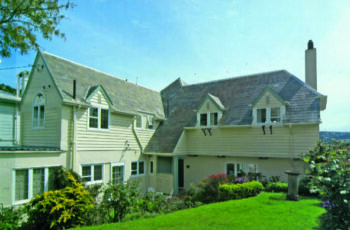
Catholic Enquiry Centre Headquarters in Wellington Austin Street, Mt Victoria, 1959-2007
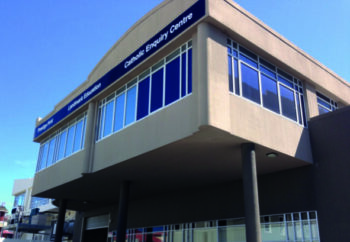
Abel Smith Street, Te Aro, 2007-2020
Almost immediately after the approval of the CEC, the bishops succeeded in buying a house to use as its base at 140 Austin St on the slopes of Mt Victoria in Wellington. It provided living space for the priests, a chapel and working area for staff.
When Fr Allan Jones took over midway through 2006, however, a hunt soon commenced for a new base. Fr Jones would not be living there and the house was beginning to need renovations, so it was decided that a more accessible location with modern office facilities would be preferable. This ended up being a long search. The house was eventually sold in November 2007 and a new venue finalised that December.
The new property at 72 Abel Smith St, close to the central city, was ideal in many ways. It was open to sun and light, being on the first level, and had spaces for reception, a board room, chapel and staff offices. On 21 November 2007, Mass was celebrated on the site for the first time. On 22 April 2008 Bishop Colin Campbell blessed the new site in the presence of the other bishops, the Board of Governors, and a good number of CEC friends and supporters.
In September 2020 came another shift. Near the centre of Wellington, parking for visitors was becoming increasingly difficult. As Fr Neil Vaney and Joe Serci were both part-time Mely was being left by herself for long periods.
As the Archdiocesan Centre refocused its work areas, a suite of offices on the ground floor of the building became available. So the CEC moved home once more. Though the space was smaller, the opportunities for cross-fertilisation with Catholic Communications, the National Liturgy Office, the national accountant and the CEO of the bishops’ conference have proved a source of creativity and camaraderie.
Governance
Up till 1988 much of the planning work, strategy and financial base of the CEC rested in the hands of the director. When Fr Paul Shannahan took charge in 1988, he called together a team of experts to give advice on advertising, structure, governance and financial operations. They came mainly from national organisations already working for the Church and included well-known names such as experienced leaders like Gary Findlay, Cardinal Williams, Pat Clegg, and Br Pat Lynch.
When Fr Allan Jones took the helm, the bishops formalised this arrangement. It came with the appointment of a Board of Governors who would oversee the overall direction and development of policy and resources, and to whom the director would report and from whom he would receive advice and support. At the inaugural meeting on 15 August 2006 the members were Peter Churchman (chair), Sr Merle Hiscock RNDM, Terry Christie, Lorraine McArthur and John McCormick. Several of these had been part of the prior Advisory group.
Over the next ten years, the membership would slowly change till the Board wrapped up in 2017. By this time the chairmanship had passed to Gerald Scanlan. One of the members, David Mullin, took on the role of acting director while the new structure of pastoral director, engagement manager and office manager was coming into being.
As preparation for this change, the bishops had appointed liaison people from each diocese to provide a sense of what was happening around the nation for those working in the capital. This group functioned 2014-16 but was not reinstated when the Board of Governors finished operating in 2017. Instead, an Advisory Board with a member from each diocese was put together. They met first in July 2018.
The members were Thérèse Lautua (Auckland); Matthew O’Connell (Christchurch); Sue Devereux (Wellington); Alex Bailey (Hamilton); Thom Saywell (Palmerston North); and Jo Bell (Dunedin). This was the structure in place in mid-2021.
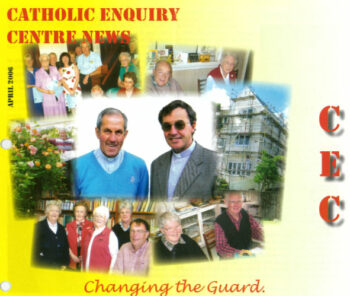
Newsletters from 2006, 2011 and 2019
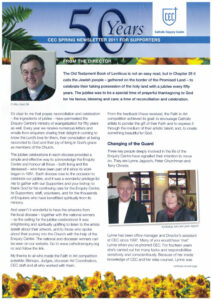
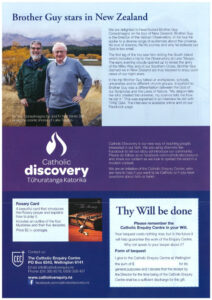
 Entries(RSS)
Entries(RSS)